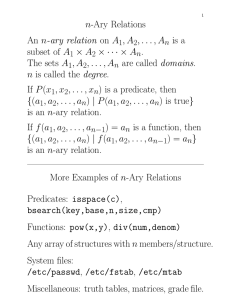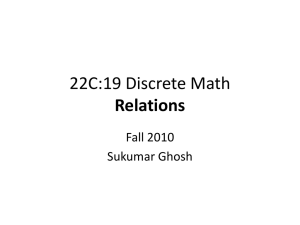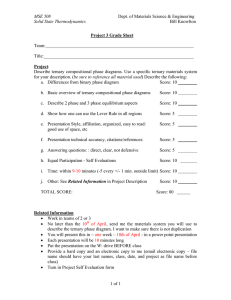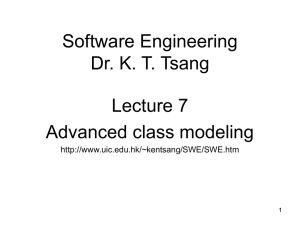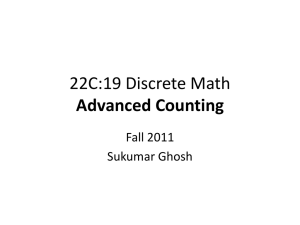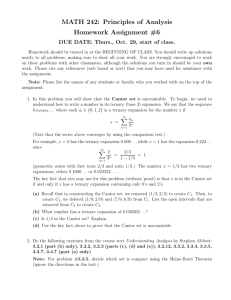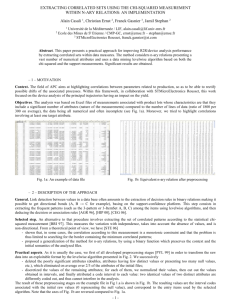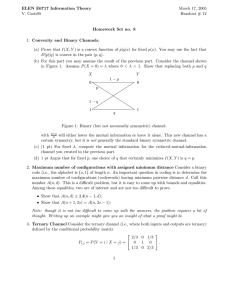SEVERAL ASPECTS ON THE HYPERGROUPS ASSOCIATED WITH -ARY RELATIONS n
advertisement
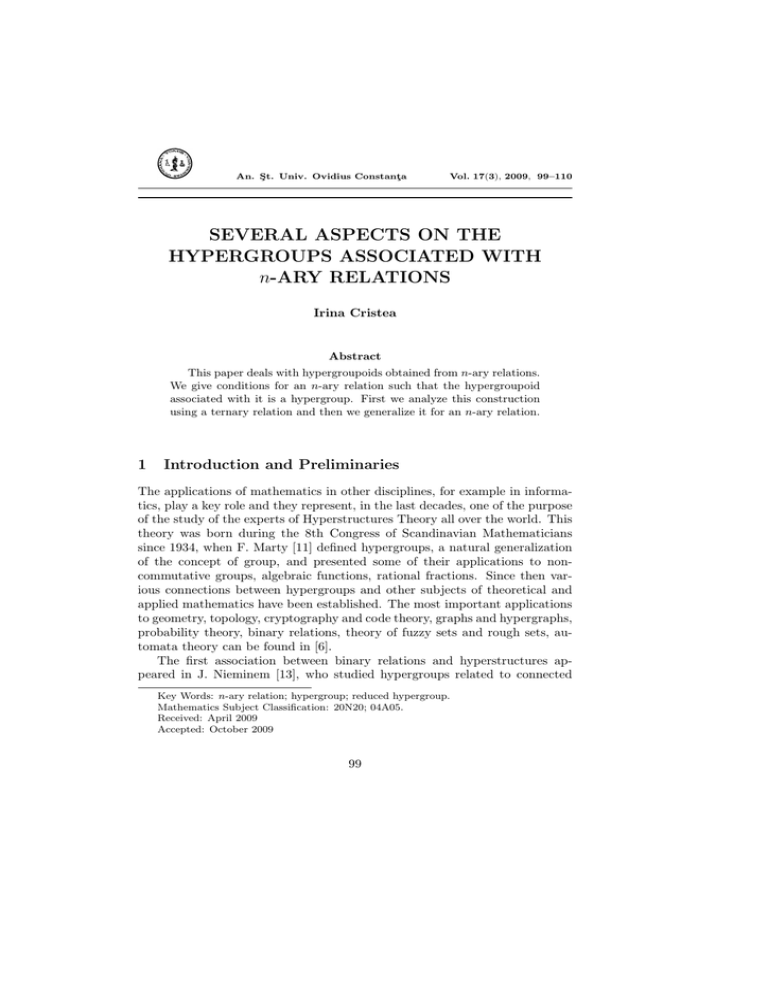
An. Şt. Univ. Ovidius Constanţa
Vol. 17(3), 2009, 99–110
SEVERAL ASPECTS ON THE
HYPERGROUPS ASSOCIATED WITH
n-ARY RELATIONS
Irina Cristea
Abstract
This paper deals with hypergroupoids obtained from n-ary relations.
We give conditions for an n-ary relation such that the hypergroupoid
associated with it is a hypergroup. First we analyze this construction
using a ternary relation and then we generalize it for an n-ary relation.
1
Introduction and Preliminaries
The applications of mathematics in other disciplines, for example in informatics, play a key role and they represent, in the last decades, one of the purpose
of the study of the experts of Hyperstructures Theory all over the world. This
theory was born during the 8th Congress of Scandinavian Mathematicians
since 1934, when F. Marty [11] defined hypergroups, a natural generalization
of the concept of group, and presented some of their applications to noncommutative groups, algebraic functions, rational fractions. Since then various connections between hypergroups and other subjects of theoretical and
applied mathematics have been established. The most important applications
to geometry, topology, cryptography and code theory, graphs and hypergraphs,
probability theory, binary relations, theory of fuzzy sets and rough sets, automata theory can be found in [6].
The first association between binary relations and hyperstructures appeared in J. Nieminem [13], who studied hypergroups related to connected
Key Words: n-ary relation; hypergroup; reduced hypergroup.
Mathematics Subject Classification: 20N20; 04A05.
Received: April 2009
Accepted: October 2009
99
100
IRINA CRISTEA
simple graphs. In the same direction P. Corsini [3] worked, considering different hyperoperations associated with graphs. J. Chvalina [1] used ordered
structures for the construction of semihypergroups and hypergroups. Later on,
I. Rosenberg [17] extended Chvalina’s definition, introducing a hyperoperation
obtained by a binary relation; the new hypergroupoid has been investigated
by P. Corsini [4], P. Corsini and V. Leoreanu [7] and recently by I. Cristea and
M. Ştefănescu [8, 9]. Lately, S. Spartalis and C. Mamaloukas [18], and Ch.G.
Massouros and Ch. Tsitouras [12] have created several algorithms in order
to calculate the number of non isomorphic hypergroupoids determined by a
binary relation on a finite set. The study of the relations between two sets, in
particular on a set, points out important properties of the discrete structures.
But also relationships among elements of more than two sets often arise and
may be expressed in terms of n-ary relations.
This paper deals with hypergroupoids obtained from n-ary relations. The
n-ary relations were studied for their applications in the theory of dependence
space. Moreover, they are used in Database Theory, providing a convenient
tool for database modeling. First we associate a hypergroupoid with a ternary
relation defined on a nonempty set H and investigate when the new hypergroupoid is a hypergroup. We use some fundamental operations on databases
to generalize the results to the case of n-ary relations. Finally we discuss some
aspects connected with the reduced hypergroupoids.
For a nonempty set H, we denote by P ∗(H) the set of all nonempty subsets
of H. A nonempty set H, endowed with a mapping, called hyperoperation,
◦ : H 2 −→ P ∗ (H) is called a hypergroupoid. A hypergroupoid which verifies
the following conditions:
1. (x ◦ y) ◦ z = x ◦ (y ◦ z), for all x, y, z ∈ H
2. x ◦ H = H = H ◦ x, for all x ∈ H (reproduction axiom)
is called a hypergroup.
If, for any x, y ∈ H, x ◦ y = H, then hH, ◦i is called the total hypergroup.
[
a ◦ b.
If A and B are nonempty subsets of H, then we denote A ◦ B =
a∈A
b∈B
We say that two partial hypergroupoids hH, ◦1 i and hH, ◦2 i are mutually associative if, for any x, y, z ∈ H we have
(x ◦1 y) ◦2 z = x ◦1 (y ◦2 z); (x ◦2 y) ◦1 z = x ◦2 (y ◦1 z).
For each pair (a, b) ∈ H 2 , set a/b = {x | a ∈ x ◦ b} and b\a = {y [
| a ∈ b ◦ y}.
a/b.
If A and B are nonempty subsets of H, then we denote A/B =
a∈A
b∈B
SEVERAL ASPECTS ON THE HYPERGROUPS
101
A commutative hypergroupoid hH, ◦i is called a join space if the following
implication holds: for any (a, b, c, d) ∈ H 4 ,
a/b ∩ c/d 6= ∅ =⇒ a ◦ d ∩ b ◦ c 6= ∅ (”transposition axiom”).
For more details on hypergroup theory, see [2].
2
Properties of the n-ary relations
In this section we present some basic notions about the n-ary relations defined
on a set H. We suppose that H 6= ∅ is a set, n ∈ N a natural number such
that n ≥ 2, and ρ ⊆ H n is an n-ary relation on H.
Definition 1. (see[15]) The relation ρ is said to be
1. reflexive if, for any x ∈ H, the n-tuple (x, . . . , x) ∈ ρ;
2. n-transitive if it has the following property: if (x1 , . . . , xn )∈ρ, (y1 , . . . , yn )∈ρ
hold and if there exist natural numbers i0 > j0 such that 1 < i0 ≤ n,
1 ≤ j0 < n, xi0 = yj0 , then the n-tuple (xi1 , . . . , xik , yjk+1 , . . . , yjn ) ∈ ρ
for any natural number 1 ≤ k < n and i1 , . . ., ik , jk+1 , . . . , jn such that
1 ≤ i1 < . . . < ik < i0 , j0 < jk+1 < . . . < jn ≤ n;
3. symmetric if (x1 , x2 , . . . , xn ) ∈ ρ implies (xn , xn−1 , . . . , x1 ) ∈ ρ;
4. strongly symmetric if (x1 , . . . , xn ) ∈ ρ implies (xσ(1) , . . . , xσ(n) ) ∈ ρ for
any permutation σ of the set {1, . . . , n};
5. n-ary preordering on H if it is reflexive and n-transitive;
6. n-equivalence on H if it is reflexive, strongly symmetric and n-transitive.
Example 2. A ternary relation ρ is 3-transitive if and only if it satisfies the
following conditions:
(i) If (x, y, z) ∈ ρ, (y, u, v) ∈ ρ, then (x, u, v) ∈ ρ.
(ii) If (x, y, z) ∈ ρ, (z, u, v) ∈ ρ, then (x, y, u) ∈ ρ, (x, y, v) ∈ ρ, (x, u, v) ∈ ρ,
(y, u, v) ∈ ρ.
(iii) If (x, y, z) ∈ ρ, (u, z, v) ∈ ρ, then (x, y, v) ∈ ρ.
Lemma 3. If ρ is an n-ary preordering, then any projection ρ1,i,n , 2 ≤ i ≤
n − 1, is a 3-ary preordering.
Proof. The reflexivity is immediately. Set an arbitrary i in {2, . . . , n − 1}.
We prove that ρ1,i,n is 3-transitive in three steps (see the Example 3):
102
IRINA CRISTEA
(i) If (x, y, z) ∈ ρ1,i,n and (y, u, v) ∈ ρ1,i,n , then there exist a1 , . . . , an−3 ,
b1 , . . . , bn−3 ∈ H such that (x, a1 , . . . , ai−2 , y, ai−1 , . . . , an−3 , z) ∈ ρ and
(y, b1 , . . . , bi−2 , u, bi−1 , . . . , bn−3 , v) ∈ ρ; by the n-transitivity of the relation ρ it follows that (x, b1 , . . . , bi−2 , u, bi−1 , . . . , bn−3 , v) ∈ ρ, that is
(x, u, v) ∈ ρ1,i,n .
(ii) If (x, y, z) ∈ ρ1,i,n and (z, u, v) ∈ ρ1,i,n , then there exist a1 , . . . , an−3 ,
b1 , . . . , bn−3 ∈ H such that (x, a1 , . . . , ai−2 , y, ai−1 , . . . , an−3 , z) ∈ ρ and
(z, b1 , . . . , bi−2 , u, bi−1 , . . . , bn−3 , v) ∈ ρ; by the n-transitivity of the relation ρ it follows that:
(x, b1 , . . . , bi−2 , u, bi−1 , . . . , bn−3 , v) ∈ ρ, that is (x, u, v) ∈ ρ1,i,n ,
(y, b1 , . . . , bi−2 , u, bi−1 , . . . , bn−3 , v) ∈ ρ, that is (y, u, v) ∈ ρ1,i,n ,
(x, a1 , . . . , ai−2 , y, bi−1 , . . . , bn−3 , v) ∈ ρ, that is (x, y, v) ∈ ρ1,i,n ,
(x, a1 , . . . , ai−2 , y, ai−1 , . . . , an−3 , u) ∈ ρ, that is (x, y, u) ∈ ρ1,i,n .
(iii) If (x, y, z) ∈ ρ1,i,n and (u, z, v) ∈ ρ1,i,n , then there exist a1 , . . . , an−3 ,
b1 , . . . , bn−3 ∈ H such that (x, a1 , . . . , ai−2 , y, ai−1 , . . . , an−3 , z) ∈ ρ and
(u, b1 , . . . , bi−2 , z, bi−1 , . . . , bn−3 , v) ∈ ρ; by the n-transitivity it follows
that: (x, a1 , . . . , ai−2 , y, ai−1 , . . . , an−3 , v) ∈ ρ, that is (x, y, v) ∈ ρ1,i,n .
Lemma 4. Let ρ be an n-ary relation on H such that ρ1,n = H × H.
If ρ is strongly symmetric and n-transitive, then ρ is an n-equivalence on H.
Proof. Set x arbitrary in H. Since ρ1,n = H×H, there exist u1 , . . . , un−2 ∈
H such that (x, u1 , . . . , un−2 , x) ∈ ρ and by the symmetry it follows that
(u1 , . . . , un−2 , x, x) ∈ ρ. Using the n-transitivity, (x, u2 , . . . , un−2 , x, x) ∈ ρ.
Again by the symmetry, we obtain that (u2 , . . . , un−2 , x, x, x) ∈ ρ and therefore, by the n-transitivity, that (x, u3 , . . . , un−2 , x, x, x) ∈ ρ and so on; finally
it results that (x, x, . . . , x) ∈ ρ, for any x ∈ H, so ρ is an n-equivalence on H.
We also obtain the following two immediate corollaries.
Corollary 5. If ρ is an n-ary equivalence, then any projection ρ1,i,n , 2 ≤ i ≤
n − 1, is a 3-ary equivalence.
Corollary 6. If ρ is a strongly symmetric n-ary relation, then, for any i 6=
j ∈ {2, . . . , n − 1}, the following equivalence holds:
(x, y, z) ∈ ρ1,i,n ⇐⇒ (x, y, z) ∈ ρ1,j,n .
SEVERAL ASPECTS ON THE HYPERGROUPS
103
There are esentially two types of operations with n-ary relations useful
to describe information manipulations in databases: the first type permits
the construction of new databases (union, intersection, diference, Cartesian
product) and the second type may be characterized as operations that are
motivated by the information manipulations (projection, join).
In the following we recall the definitions of the projection and the join.
Definition 7. Let ρ be an n-ary relation on a nonempty set H and k < n.
The (i1 , . . . , ik )-projection of ρ, denoted by ρi1 ,...,ik , is a k-ary relation on H
defined by: if (a1 , . . . , an ) ∈ ρ, then (ai1 , . . . , aik ) ∈ ρi1 ,...,ik .
Definition 8. Let ρ be an m-ary relation on a nonempty set H, λ an nary relation on the same set H. The join of ρ and λ, denoted by Jp (ρ, λ),
where 1 ≤ p < m, 1 ≤ p < n, is an (m + n − p)-relation on H that consists of all (m + n − p)-tuples (a1 , . . . , am−p , c1 , . . . , cp , b1 , . . . , bn−p ) such that
(a1 , . . . , am−p , c1 , . . . , cp ) ∈ ρ and (c1 , . . . , cp , b1 , . . . , bn−p ) ∈ λ.
Example 9. On H = {1, 2, 3, 4, 5, 6} we define the 5-ary relation ρ and the
ternary relation λ:
ρ = {(1, 1, 3, 4, 1), (2, 3, 5, 2, 1), (3, 3, 4, 5, 1),
λ = {(4, 1, 6), (5, 1, 2), (3, 4, 3), (2, 2, 2)}.
The ρ2,4,5 projection is the ternary relation ρ2,4,5 = {(1, 4, 1), (3, 2, 1), (3, 5, 1)};
the join J2 (ρ, λ) is the 6-ary relation J2 (ρ, λ) = {(1, 1, 3, 4, 1, 6), (3, 3, 4, 5, 1, 2)}.
3
Hypergroups associated with n-ary relations
In the paper [19] M. Ştefănescu proposes, as a problem, the study of the
hyperstructure associated with a ternary relation as follows:
(a, b, c) ∈ ρ if and only if c ∈ a ◦ b.
In this section we consider this problem, but in a little different form.
Let ρ be a ternary relation on H. For any x, y ∈ H, we define the hyperproduct
x ◦ρ y = {z | z ∈ H, (x, z, y) ∈ ρ}.
We notice that hH, ◦ρ i is a hypergroupoid if and only if, for any x, y ∈ H,
there exists z ∈ H such that (x, z, y) ∈ ρ, that is the projection ρ1,3 is the
total relation, i.e. ρ1,3 = H × H.
Now we generalize the definition of the hyperproduct associated with a
ternary relation to the case of n-ary relation, n ≥ 3, defined on a nonempty
set H.
104
IRINA CRISTEA
Definition 10. Let ρ be an n-ary relation on H. For any i ∈ {2, . . . , n−1},
using the projections ρ1,i,n , we define the hyperproducts:
x ◦i y = {z ∈ H | (x, z, y) ∈ ρ1,i,n }
and
x ◦ρ y = {z ∈ H | (x, z, y) ∈
n−1
[
i=2
ρ1,i,n } =
n−1
[
x ◦i y.
i=2
We notice that hH, ◦ρ i is a hypergroupoid if and only if the projection ρ1,n is
the total relation, i.e. ρ1,n = H × H.
In the following we determine neccessary conditions such that the hypergroupoid hH, ◦ρ i is a hypergroup or a join space.
Proposition 11. Let ρ be an n-ary relation on H. Then hH, ◦ρ i is a quasihypergroup if and only if ρ1,n = H × H and there exist i, j, with 2 ≤ i, j ≤ n − 1,
such that ρ1,i = ρj,n = H × H.
Proof. We know that a hypergroupoid hH, ◦i is a quasihypergroup if
and only if, for any x ∈ H, x ◦ H = H = H ◦ x. Therefore hH, ◦ρ i is
a quasihypergroup iff , for any x, y ∈ H, there exist z, t ∈ H, such that
n−1
[
ρ1,i,n ∋ (t, y, x). It follows that
y ∈ x ◦ρ z ∩ t ◦ρ x, that is (x, y, z) ∈
i=2
hH, ◦ρ i is a quasihypergroup iff there exist i, j, with 2 ≤ i, j ≤ n − 1, such that
(x, y, z) ∈ ρ1,i,n and (t, y, x) ∈ ρ1,j,n , so ρ1,i = ρj,n = H × H.
Proposition 12. Let ρ be an n-ary relation on H such that ρ1,n = H × H.
If ρ is a preordering, then hH, ◦ρ i is the total hypergroup.
Proof. We have to prove that, for any x, y, z ∈ H, z ∈ x ◦ρ y.
Set x, y, x ∈ H. Since ρ1,n = H × H, there exist a1 , a2 , . . . , an−2 ∈ H, such
that (z, a1 , . . . , an−2 , y) ∈ ρ. By the reflexivity, (z, z, . . . , z) ∈ ρ and then, by
the n-transitivity, it follows that (z, . . . , z, y) ∈ ρ. Again since ρ1,n = H × H,
there exist c1 , . . . , cn−2 ∈ H such that (x, c1 , . . . , cn−2 , z) ∈ ρ. Using the ntransitivity for (z, . . . , z, y) ∈ ρ and (x, c1 , . . . , cn−2 , z) ∈ ρ, we obtain that
(x, z, . . . , z, y) ∈ ρ, so z ∈ x ◦ρ y.
Proposition 13. Let ρ be an n-ary relation on H such that ρ1,n = H ×H. If ρ
is n-ary transitive and strongly symmetric, then hH, ◦ρ i is the total hypergroup.
Proof. By Lemma 4, ρ is an n-equivalence on H and by the previous
proposition, hH, ◦ρ i is the total hypergroup.
Proposition 14. Let ρ be a ternary relation on H such that ρ1,3 = ρ1,2 =
H × H or ρ1,3 = ρ2,3 = H × H. If ρ is 3-transitive, then hH, ◦ρ i is the total
hypergroup.
105
SEVERAL ASPECTS ON THE HYPERGROUPS
Proof. We prove that ρ is reflexive and then, by Proposition 12, it results
the conclusion. We suppose that ρ1,3 = ρ1,2 = H × H; thus, for any x ∈ H,
there exist ax , cx ∈ H such that (x, ax , x) ∈ ρ and (ax , x, cx ) ∈ ρ. Then by
the 3-transitivity, (x, x, cx ) ∈ ρ. Again, since ρ1,3 = H × H it follows that
there exists ux ∈ H such that (cx , ux , x) ∈ ρ. Using the 3-transitivity for
(x, x, cx ), (cx , ux , x) ∈ ρ, we get (x, x, x) ∈ ρ, that is ρ is a 3-preordering on
H.
Corollary 15. Let ρ be an n-ary relation on H (n ≤ 4) such that there exist
i, j, with 2 ≤ i, j ≤ n − 1, such that ρ1,i = ρj,n = ρ1,n = H × H. If ρ is
n-transitive, then hH, ◦ρ i is the total hypergroup.
Proof. If ρ is n-transitive, then the ternary relations λ = ρ1,i,n and α =
ρ1,j,n are 3-transitive such that λ1,2 = λ1,3 = H ×H and α2,3 = α1,3 = H ×H.
By Proposition 14 it follows that the hypergroupoids hH, ◦i i and hH, ◦j i are
n−1
[
x◦ρ1,l,n y ⊇
total hypergroups. therefore, for any x, y ∈ H, we have x◦ρ y =
l=2
x ◦ρ1,i,n y = H, so x ◦ρ y = H, that is, hH, ◦ρ i is the total hypergroup.
Let ρ be a ternary relation on H. We denote the join relation J2 (ρ, ρ) by
α.
We recall that J2 (ρ, ρ) is a 4-relation such that
(x, y, z, t) ∈ J2 (ρ, ρ) ⇐⇒ (x, y, z), (y, z, t) ∈ ρ.
Using projections of J2 (ρ, ρ), we give a neccessary condition for a hypergroupoid hH, ◦ρ i to be a semihypergroup.
Proposition 16. Let ρ be a reflexive and symmetric ternary relation on H.
If ρ 6⊂ α1,2,4 or ρ 6⊂ α1,3,4 , then the hyperoperation ”◦ρ ” is not associative.
Proof. We suppose that ρ 6⊂ α1,2,4 ; then there exists (x, y, z) ∈ ρ \ α1,2,4
and thus, for any a ∈ H,
(x, y, a, z) 6∈ J2 (ρ, ρ).
(1)
Since ρ is reflexive and (x, y, z) ∈ ρ, it follows that y ∈ y ◦ρ y ⊂ (x ◦ρ z) ◦ρ y.
To prove that ”◦ρ ” is not associative, it is enough to show that y 6∈ x◦ρ (z ◦ρ y),
that is, for any a ∈ z ◦ρ y, y 6∈ x ◦ρ a.
Let’s suppose by the absurd that there exists ā ∈ z ◦ρ y, with y ∈ x ◦ρ ā.
Then, (z, ā, y) ∈ ρ (and by the symmetry (y, ā, z) ∈ ρ) and (x, y, ā) ∈ ρ.
Therefore it results that (x, y, ā, z) ∈ J2 (ρ, ρ), which is a contradiction with
(1). Similarly if we suppose ρ 6⊂ α1,3,4 .
106
IRINA CRISTEA
Corollary 17. Let ρ be a reflexive and symmetric ternary relation on H. If
hH, ◦ρ i is a semihypergroup, then ρ ⊂ α1,2,4 ∩ α1,3,4 .
In the following we give a similar result for the n-ary relations. Let ρ
be an n-ary relation on H and α be the join relation J2 (ρ, ρ); then α is a
(2n − 2)-relation on H.
Proposition 18. Let ρ be a reflexive and symmetric n-ary relation on H
which satisfies the condition:
(S) : (x, a1 , . . . , an−2 , y) ∈ ρ ⇐⇒ (x, aσ(1) , . . . , aσ(n−2) , y) ∈ ρ,
for any permutation σ of the set {1, 2, . . . , n − 2}.
If, there exists j ∈ {2, . . . , n − 1} such that ρ1,j,n 6⊂ α1,n−1,2n−2 or ρ1,j,n 6⊂
α1,n,2n−2 , then the hyperoperation ”◦ρ ” is not associative.
Proof. First we suppose there exists j ∈ {2, . . . , n − 1} such that ρ1,j,n 6⊂
α1,n,2n−2 . Then there exists (x, y, z) ∈ ρ1,j,n such that (x, y, z) 6∈ α1,n,2n−2 .
Therefore, y ∈ x ◦ρ z and since ρ is reflexive, it follows that y ∈ y ◦ρ (x ◦ρ z).
We prove that y 6∈ (y ◦ρ x) ◦ρ z , and thus the hyperoperation ”◦ρ ” is not
associative.
Let’s suppose by the absurd that y ∈ (y ◦ρ x) ◦ρ z; then there exists a ∈ y ◦ρ x
such that y ∈ a ◦ρ z. It follows that (y, . . . , a, . . . , x) ∈ ρ and (a, . . . , y, . . . , z) ∈
ρ. By the simmetry and the condition (S), we obtain that (x, . . . , a, y) ∈ ρ and
(a, y, . . . , z) ∈ ρ and therefore (x, . . . , a, y, . . . , z) ∈ J2 (ρ, ρ), that is (x, y, z) ∈
α1,n,2n−2 which contradicts our supposition.
We proceed similarly if we suppose there exists j ∈ {2, . . . , n− 1} such that
ρ1,j,n 6⊂ α1,n−1,2n−2 : one can prove that y ∈ (x ◦ρ z) ◦ρ y, but y 6∈ x ◦ρ (z ◦ρ y),
so the hyperoperation ”◦ρ ” is not associative.
4
An example of reduced hypergroup
It may happen that the hyperoperation ”◦” does not discriminate between
a pair of elements of H, when two elements play interchangeable roles with
respect to the hyperoperation. On a hypergroupoid hH, ◦i, the following three
equivalence relations, called the operational equivalence, the inseparability and
the essential indistinguishability, respectively, may be defined (see [10]):
• x ∼o y ⇐⇒ x ◦ a = y ◦ a and a ◦ x = a ◦ y, for any a ∈ H;
• x ∼i y ⇐⇒ for a, b ∈ H, we have x ∈ a ◦ b ⇐⇒ y ∈ a ◦ b;
• x ∼e y ⇐⇒ x ∼o y and x ∼i y.
107
SEVERAL ASPECTS ON THE HYPERGROUPS
For any x ∈ H, let x
bo , x
bi and x
be , respectively, denote the equivalence classes
of x with respect to the relations ∼o , ∼i and ∼e .
We say that a hypergroupoid hH, ◦i is reduced if and only if, for any x ∈ H,
x
be = {x}.
[
Let H be a nonempty set such that H =
Hi , where {Hi }i∈I is a family
i∈I
of subsets of H indexed by a set I. We define on H the binary relation ρb as
follows
(x, y) ∈ ρb ⇐⇒ ∃i ∈ I : x, y ∈ Hi .
Using the join operation we obtained the ternary relation ρ defined as:
ρ = J1 (ρb , ρb ) = {(x, z, y) | (x, z) ∈ ρb ∧ (z, y) ∈ ρb } =
= {(x, z, y) | ∃i, j ∈ I : x, z ∈ Hi ∧ z, y ∈ Hj }.
As in the previous section, we consider the hyperproduct on H defined by
x ◦ρ y = {z | (x, z, y) ∈ ρ}.
(2)
It is obvious that
x ◦ρ y = x ◦ρ x ∩ y ◦ρ y
and if we denote x ◦ρ x by Hx , then
x ◦ρ y = Hx ∩ Hy .
We notice that hH, ◦ρ i is a partial hypergroupoid and it is a hypergroupoid
if and only if, for any i 6= j ∈ I, Hi ∩ Hj 6= ∅. We are interested in finding
conditions such that the hypergroupoid hH, ◦ρ i is reduced.
Proposition 19. Let hH, ◦ρ i be a partial hypergroupoid associated with a
ternary relation as in (2). For any x, y ∈ H, x ∼e y if and only if Hx = Hy .
Proof. First we notice that, for any a, b ∈ H, a ∈ Hb if and only if b ∈ Ha .
Let x, y be in H such that x ∼o y, that is x ◦ρ a = y ◦ρ a, for any a ∈ H;
thus x ◦ρ x = x ◦ρ y = y ◦ρ x = y ◦ρ y and then Hx = Hy .
Conversely, set x, y ∈ H such that Hx = Hy ; then, for any a ∈ H, we have
Hx ∩ Ha = Hy ∩ Ha , therefore x ◦ρ a = y ◦ρ a, so x ∼o y.
Now set x, y ∈ H such that x ∼i y, thus x ∈ a ◦ρ b if and only if y ∈ a ◦ρ b.
Let z ∈ Hx , then x ∈ Hz = z ◦ρ z and since x ∼i y, it follows that y ∈ Hz ,
thus z ∈ Hy . So Hx ⊂ Hy and similarly one can prove that Hy ⊂ Hx .
Conversely, set x, y ∈ H such that Hx = Hy . If x ∈ a ◦ρ b = Ha ∩ Hb ,
with a, b ∈ H, then a, b ∈ Hx = Hy and therefore y ∈ Ha ∩ Hb = a ◦ρ b, so
x ∼i y.
108
IRINA CRISTEA
Proposition 20. Let {Hi }i∈I be a partition of a nonempty set H. Then
the family of the equivalence classes respected to the equivalence ∼e on hH, ◦ρ i
coincides with the family {Hi }i∈I . Moreover, the partial hypergroupoid hH, ◦ρ i
is reduced if and only if , for any i ∈ I, | Hi |= 1.
Proof. Let {Hi }i∈I be a partition of H. For any x 6= y ∈ H, there exist
and are unique i0 , j0 ∈ I such that x ∈ Hi0 and y ∈ Hj0 . Since {Hi }i∈I is a
partition of H, it follows that Hx = Hi0 and Hy = Hj0 and then
x ∼e y ⇐⇒ Hx = Hy ⇐⇒ ∃!i0 ∈ I : x, y ∈ Hi0 ,
so the family of the equivalence classes respected to ”∼e ” is {Hi }i∈I .
Moreover, hH, ◦ρ i is reduced if and only if, for any x 6= y ∈ H, x 6∼e y,
which is equivalent with Hx = {x}, for any x ∈ H, so | Hi |= 1, for any
i ∈ I.
5
Conclusions and future work
Many connections between hypergroups and binary relations have been considered and investigated. In this paper we associated, firstly with a ternary
relation, and secondly with an n-ary relation, a partial hypergroupoid. We
determined neccessary conditions such that the obtained hyperstructure is a
hypergroup. Let ρ be a ternary relation on H. For any x, y ∈ H, we define
the hyperproduct
x ◦ρ y = {z | z ∈ H, (x, z, y) ∈ ρ}.
We notice that we can do the association also in the other direction: given a
hypergroupoid hH, ◦i, we define the ternary relation ρ on H setting (x, y, z) ∈ ρ
if and only if y ∈ x ◦ z. This is the unique ternary relation obtained in this
way. We can not say the same thing in the case of n-ary relation, n ≥ 4.
The operations on databases (such union, intersection, Cartesian product,
projection, join) can be extended to similar operations on n-ary relations that
permit to construct new hypergroupoids. It would be interesting to determine
some relationships between the hypergroupoids associated with two n-ary relations ρ and λ and the hypergroupoids associated with the union, intersection,
join, Cartesian product of ρ and λ.
References
[1] Chvalina, J., Commutative hypergroups in the sense of Marty and ordered
sets, Proc. Summer School on General Algebra and Ordered Sets (1994),
Olomouc (Czech Republic), 19–30.
SEVERAL ASPECTS ON THE HYPERGROUPS
109
[2] Corsini, P., Prolegomena of Hypergroups Theory, Aviani Editore, 1993.
[3] Corsini, P., Hypergraphs and hypergroups, Algebra Universalis, 35(1996),
548–555.
[4] Corsini, P., On the Hypergroups Associated with Binary Relations, Multi.
Val. Logic, 5(2000), 407–419.
[5] Corsini, P., Binary relations, interval structured and join spaces, J. Appl.
Math. Comput., 10(2002), no. 1-2, 209–216.
[6] Corsini, P., Leoreanu, V., Applications of Hyperstructure Theory, Kluwer
Academic Publishers, Advances in Mathematics, 2003.
[7] Corsini, P., Leoreanu, V., Hypergroups and binary relations, Algebra Universalis, 43(2000), 321–330.
[8] Cristea, I., Stefănescu, M., Binary relations and reduced hypergroups, Discrete Math., 308(2008), 3537-3544.
[9] Cristea, I., Stefănescu, M., Hypergroups and n-ary relations, submitted
(2009).
[10] Jantosciak, J., Reduced Hypergroups, Algebraic Hyperstructures and Applications (T. Vougiouklis, ed.), Proc. 4th Int. cong. Xanthi, Greece, 1990,
World Scientific, Singapore,(1991), 119–122.
[11] Marty, F.,Sur une généralization de la notion de group, Eight Congress
Math. Scandenaves, Stockholm, (1934), 45–49.
[12] Massouros, Ch.G., Tsitouras, Ch., Enumeration of hypercompositional
structures defined by binary relations, submitted.
[13] Nieminen, J., Join space graphs, J.Geom., 33(1988), 99–103.
[14] Novak, V., On representation of ternary structures, Math. Slovaca,
45(1995), no.5, 469–480.
[15] Novak, V., Novotny, M., Pseudodimension of relational structures,
Czech.Math.J., 49(1999), no.124, 547–560.
[16] Novotny, M.,Ternary structures and groupoids, Czech.Math.J., 41(1991),
no.116, 90–98.
[17] Rosenberg, I.G.,Hypergroups and join spaces determined by relations, Ital.
J. Pure Appl. Math., 4(1998), 93–101.
110
IRINA CRISTEA
[18] Spartalis, S., Mamaloukas, C., On hyperstructures associated with binary
relations, Comput. Math. Appl., 51, no.1, (2006), 41–50.
[19] Stefănescu, M., Some interpretations of hypergroups, Bull. Math. Soc. Sci.
Math. Roumanie, 49(97) (2006), no.1, 99–104.
Irina Cristea
DIEA, University of Udine, Italy
irinacri@yahoo.co.uk
